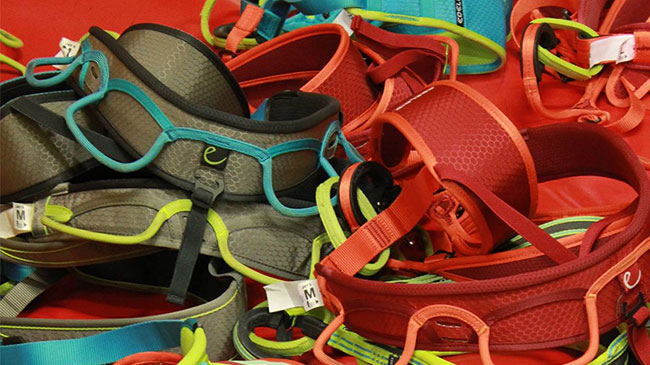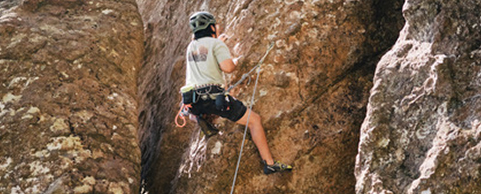When Should I Retire My Climbing Harness?

Replacing your climbing harness: How to tell if it's time to get a new one.
Retiring your climbing harness is something you'll do several times during your climbing career. Why you do it is a no-brainer: If your harness fails, you're likely to get injured or even lose your life. So, it's worth inspecting your climbing harness regularly. But, how do you work out when exactly when you need to replace your harness?
There are THREE main reasons why you might replace your climbing harness:
- Your body size has changed
- Your harness is old
- Your harness is showing signs of significant wear and tear
If you've changed shape
Maybe you've put on some muscle. Or, maybe you've had a baby. Your body has changed, and therefore your harness fits differently. Often it's not as comfortable, because there isn't enough waist padding to go around, and you end up with webbing digging into your hips.
When you get a new harness due to a change in body shape, generally, it's for comfort reasons, as opposed to safety reasons.
An exception is a scenario in which you've gotten so thin that the harness – done up to its smallest size – can slide over your hips. That's a safety issue, and it's definitely worth getting a new climbing harness, in that case.
Harness age
'Old' doesn't necessary mean 'ancient'. Your harness doesn't need to be fraying at the edges and fossilising to be considered 'old'. All harnesses have an official life span, which is determined by the manufacturer.
The first thing you need to do is find your harness' date of manufacture. This is printed somewhere on your harness. And, it refers to the exact date your particular harness was made.
Next, you'll need to seek out the life span of your manufacturer's harnesses. It's best to consult the most up-to-date information you can find: look for this in the packaging your harness came in, or on the manufacturer's website.
As a guide, we've pulled information compiled by Rock + Water Adventures in a booklet called Summary of Manufacturers' Stated Maximum Life for Obsolescence of Recreational Climbing Equipment, which was last updated on 2 March 2017. See below.
| 5 years of use, 10 years from manufacture, whichever comes first. | Black Diamond Wild Country |
| 7 years from first use, 10 years from manufacture, whichever comes first. | Mammut |
| 10 years from manufacture. | CAMP DMM Petzl |
| 10 years from first use, 12 years from manufacture, whichever comes first. | Edelrid |
| 10 years from first use, 15 years from manufacture, whichever comes first. | Beal Rock Empire |
Damaged, worn out harnesses
Things to check for:
- Any damage
- Deformation (e.g. deformed buckle)
- Adverse contamination (e.g. petrol)
- Excessive wear
- Obvious signs of UV degradation (e.g. bleaching or discolouration)
When it comes to 'significant wear and tear', how do you define 'significant'? Should you be worried about every nick and scuff on your harness? Read on...
The 10% rule
The general rule is 10%. What does that mean? Say there's a piece of webbing on your harness that's showing some wear. If it's worn down to 91% of its original width, in theory it's still usable. If it's worn down to 90% of its original width, you should retire the harness.
The 10% rule applies to any structural material on the harness. What's considered 'structural'? That's more difficult to determine than you'd think. For instance, waist band webbing that goes all the way around your waist is structural. But, on a Petzl Luna harness (for example), the waist webbing looks like it wraps around your entire waist – but, in fact, it doesn't. This means that some of the edging material on the waist band is actually considered structural.
Confused? We have a simple solution: The GOLDEN RULE is IF IN DOUBT, CHUCK IT OUT.
UV damage
The 10% rule also applies severe UV damage, which can cause discolouration. You can check for discolouration by comparing suspicious bits of webbing to a section of the webbing that's facing inward (and, hence, never sees the sun – it's likely to be the original colour).
Exposure to solvents = bad
Solvents (e.g. petrol) eat nylon. If you're at all suspicious that your harness may have been exposed to solvents such as petrol, throw it away. Why? Because you won't be able to see or smell solvents on your harness.

Fig. 1: The leg loop cross strap on the DMM Renegade harness features bright red protective material so that it's easier to see when it's worn out.
FAQ
Is there a particular area on climbing harnesses that commonly wears out?
In many cases of wear-and-tear, it's the leg loop cross strap (the bit that goes through the belay loop) that wears out first. Manufacturers are aware of this. That's why you'll find that on most harnesses, this piece of webbing has an extra bit of protective material on it (see Fig. 1 and Fig. 2).
How this piece of webbing gets worn down is by having the rope rub against it. For instance, when you're falling. Yes: This means that dogging lots of sport routes and taking lots of falls in the gym can speed up the wear on this part of the harness.

Fig. 2: Many Edelrid harnesses, such as the Edelrid Jay, features leg loop cross straps protected by an abrasion protector for extra durability.
When you're inspecting this part of the harness, apply the 10% rule. Also, if you've worn through the protective material, it's time to replace your harness.
My harness is fluffy. Is that bad?
If your harness is fluffy, either you've been using it a lot, or it's likely more than 10 years old. In both cases, you should probably replace it.
See our range of climbing harnesses.
Questions? Visit us, email us or call us (03 9600 0599).
More Articles
- HARNESSES FOR ROCK CLIMBING
- CLIMBING HARNESSES FOR KIDS
- MAINTENANCE OF CLIMBING EQUIPMENT
- MORE RESOURCES...


















